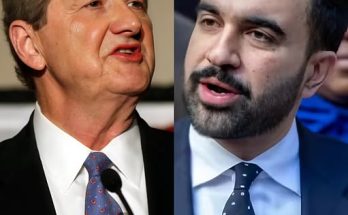
THE BLUE WALL CRACKS: WHY SOME DEMOCRATS ARE MOVING RIGHT — AND WHAT IT REVEALS ABOUT AMERICA’S POLITICAL FUTURE
When Senator Josh Hawley warned that “a reckoning is coming for the Democratic establishment,” few in Washington took him literally. But recent weeks have brought a surprising wave of defections — or at least rhetorical shifts — from Democrats who now openly side with Republicans on key issues. From the government shutdown fight to cultural policy clashes, these shifts are more than short-term maneuvers. They reflect a deeper, longer-term change in how Americans — and their representatives — see party identity.
The headlines are dramatic: Democrats turning red. But beneath the sensationalism lies something more nuanced, and perhaps more consequential — a party system that no longer cleanly contains the ideological range of the country it represents.

THE SHUTDOWN SHOWDOWN
The trigger, according to many insiders, was the most recent government funding crisis — a chaotic, drawn-out confrontation that once again brought Washington to the brink. This time, the fault lines didn’t run neatly between Republicans and Democrats. They ran within both parties.
Several centrist Democrats, frustrated by leadership’s unwillingness to compromise on spending priorities and border policy, broke ranks. They joined Republicans to advance a short-term funding measure that excluded progressive policy riders — effectively ending the standoff but exposing deep internal discontent.
For conservatives, this was evidence of what Hawley called “the quiet collapse of Democratic unity.” For moderates, it was a pragmatic decision: avoid another shutdown, protect local economies, and show voters that bipartisan governance is still possible.
But for the Democratic Party’s progressive wing, the move was nothing short of betrayal. Representative Pramila Jayapal, chair of the Congressional Progressive Caucus, called it “a gift to the far right” and warned that “some of our colleagues are confusing pragmatism with surrender.”
The divide wasn’t just over a single bill — it was philosophical. It raised a larger question: what does it mean to be a Democrat in 2025?
A PARTY STRETCHED THIN
The Democratic Party has long prided itself on being a “big tent” — a coalition of urban liberals, suburban moderates, union workers, and communities of color. But that tent is beginning to strain under the weight of its contradictions.
Economically, Democrats are split between two visions: one that embraces government-led redistribution and social investment, and another that emphasizes market stability and deficit control. Culturally, they are torn between progressive advocacy for social change and a centrist instinct for caution, especially in swing states.
The result is a party that looks unified on paper but fractured in practice.
When lawmakers from Rust Belt districts side with Republicans on energy policy or border security, it’s not necessarily ideological betrayal. It’s survival. These districts have grown increasingly skeptical of what they see as “coastal liberalism” — a political language that doesn’t resonate with their day-to-day concerns.
As one unnamed Democratic aide put it in Politico, “You can’t win reelection talking about abstract justice when your constituents are asking about gas prices.”

THE HAWLEY EFFECT
Josh Hawley, the populist senator from Missouri, has been quick to seize on these divisions. Known for his sharp criticism of corporate power and cultural liberalism alike, Hawley has positioned himself as the spokesperson for a working-class conservatism that blurs traditional party lines.
In a recent Senate speech, he accused Democratic leaders of “abandoning the American worker while chasing Silicon Valley money.” That accusation struck a chord — not only with Republicans, but with a surprising number of moderate Democrats who share concerns about the party’s growing detachment from working-class voters.
Hawley’s argument is simple, and politically potent: the old labels of “left” and “right” no longer capture the real divide. Instead, it’s “the ruling class” versus “the rest.”
For some Democrats, particularly those representing economically distressed districts, that framing feels uncomfortably accurate. The result? Quiet crossover votes, soft alignments, and, in some cases, public defections that make headlines but reflect a much larger undercurrent.
IDEOLOGY VS. IDENTITY
The defection of Democrats toward Republican positions isn’t entirely new. Throughout American history, political realignments have periodically reshaped the landscape — from the Southern Democrats’ exodus in the 1960s to the Reagan Democrats of the 1980s.
What makes this moment distinct is that the defection is not purely ideological. It’s cultural and psychological.
Polls show that a growing share of Americans no longer feel comfortable with either major party. Many self-described Democrats now say they vote based on “common sense” or “community values” rather than party doctrine. In that environment, politicians who follow their voters across the aisle aren’t necessarily betraying their party — they’re reflecting a wider mood of disillusionment.
Hawley’s “truth,” as his supporters describe it, is that populism has become a kind of shared language across both parties — a language of frustration with elites, skepticism of globalization, and resentment toward cultural gatekeepers.
Democrats who echo that language may still oppose the GOP on policy, but they’ve begun to sound, rhetorically, like Republicans.
THE MEDIA SPIN
Media coverage of the defections has been predictably polarized. Right-leaning outlets have framed them as proof of a Democratic collapse, while progressive commentators have dismissed them as overhyped “anomalies.”
Yet, in quieter corners of the political class, there is genuine concern about what these shifts portend. If a significant number of Democratic lawmakers continue to distance themselves from party leadership, the result could be a new bloc of swing legislators — ideologically unpredictable, but powerful enough to decide the fate of key legislation.
Already, informal alliances have begun to form between moderate Democrats and conservative Republicans on issues like crime policy, small business regulation, and education. It’s not a full-scale realignment, but it hints at one.
For the White House, this poses a dilemma. President Biden has built his brand on unity and bipartisanship, but too much compromise risks alienating progressives. Too little risks losing moderates to the other side. It’s a delicate balancing act — one that grows harder with every new defection headline.

THE FUTURE OF THE DEMOCRATIC COALITION
The challenge for Democrats isn’t just about preventing defections. It’s about rediscovering a coherent identity. The party’s great strength — its diversity of ideas and constituencies — has become a weakness in an era that rewards simplicity and emotional clarity.
Republicans, for all their internal divisions, have mastered the art of narrative unity. “America First,” “Secure the Border,” “Protect the Family” — whatever one thinks of the content, the message is clear, repeatable, and visceral. Democrats, by contrast, often sound fragmented: too many priorities, too many caveats, too many disclaimers.
If voters perceive the party as uncertain about what it stands for, defections will continue — not only among lawmakers, but among the electorate itself.
The next two years will test whether Democrats can reassert a moral and economic vision that speaks to all corners of the country, not just its progressive enclaves.
A REALIGNMENT IN SLOW MOTION
What’s happening now may ultimately be remembered not as a collapse, but as the start of a long-term realignment.
In this realignment, Republicans like Hawley and JD Vance are courting the working class with promises of economic nationalism, while Democrats increasingly rely on educated urban and suburban voters. The two parties are trading places in the class structure — a process that’s been underway since at least the 2016 election.
Democrats who “turn red” may simply be the first visible signs of that evolution. They are the politicians trying to survive in districts where cultural conservatism runs deep but economic anxiety runs deeper.
Their defections may anger party leadership, but they also expose a truth Washington hates to admit: voters, not parties, now define the rules of engagement.
CONCLUSION: THE NEW POLITICS OF DEFECTION
So, are Democrats truly “turning red”? The answer depends on what one means by “red.” Few are becoming Republicans in name. But many are adopting the populist tone and priorities that once defined the GOP’s insurgent right.
That transformation — cultural more than partisan — could reshape both parties in the years ahead.
As the government shutdown fades into memory, the fissures it revealed remain. The Democrats’ challenge is not just to stop the bleeding. It’s to ask themselves why some of their own are choosing to walk away — and whether the party still has room for the kind of voices that once made it the natural home for America’s working class.
Because if it doesn’t, then Josh Hawley’s warning may yet prove prophetic: this isn’t just a temporary rift. It’s the start of something much bigger — the slow, steady reordering of American politics.



